Ethiopia Landmarks and Monuments
(Ethiopia, ET, East Africa)
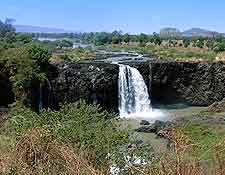
A number of impressive geological features and man-made monuments make Ethiopia a fascinating place to visit. These striking landmarks range from waterfalls and caves, to statues and ancient monoliths that are shrouded in mystery even to this day.
Consider taking an excursion to see the Sof Omar Cave, the Lion of Judah Monument or Menelik II Square, all of which reside in Addis Ababa. Other popular sights in Ethiopia include the Church of St. George at Lalibela, the Axum obelisks, and the simply awesome Blue Nile waterfalls, which has become a much photographed natural beauty spot.
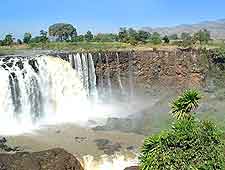
Blue Nile / Tisisat Falls
Address: Bahir Dar, Ethiopia, ET, Africa
The Tisisat Falls are an awe inspiring and spectacular sight that you can hear long before you actually see them. Visitors cannot fail to be transfixed by the sight of the Blue Nile as it plunges more than 50 m / 164 feet into the gorge below. The fabled source of the Nile is Lake Tana, some 30 km / 18 miles upstream. The best time to visit the Falls is during Ethiopia's rainy season, when they are in full flow and especially impressive. The Falls are easy to access from the nearby village of Bahir Dar.
Open hours: daily - 07:00 to 17:30
Admission: charge
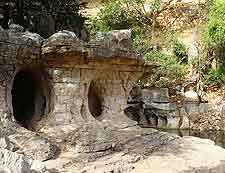
Sof Omar Cave
Address: Bale, Addis Ababa, Ethiopia, ET, Africa
Sof Omar Cave is remarkable for a number of reasons. First, it extends to over 15 km / 9.5 miles in length, making it the longest of Ethiopia's caves. Second, it has over 42 entrances, although only a handful are actually used to gain access nowadays. The largest of these, where the Web River heads underground, is known as Ayiew Maco and is situated close to the village of Sof Omar. Once the refuge of a medieval Muslim holy man, the Sof Omar Cave remains a sacred site to this day. It is also home to such cave-dwelling creatures as bats and crustaceans, as well as unusual geological features, including the Chamber of Columns.
Open hours: daily
Admission: charge
Stones of Tiya
Address: Tiya, Ethiopia, ET, Africa
The 'stales' or obelisks of Tiya in southern Ethiopia are an impressive sight. Indeed, UNESCO has made them a World Heritage Site. There are 36 stones in total, the tallest of which is some 3.7 m / 12 feet in height. The majority of these stones are decorated with carvings.
Open hours: daily
Admission: free
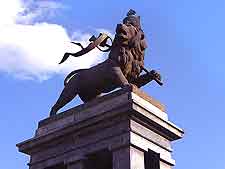
Lion of Judah Monument
Address: Addis Ababa, Ethiopia, ET, Africa
Those who arrive in Addis Ababa by train can't fail to miss one of the city's most distinctive monuments located right in front of the railway station. Standing on a black granite plinth, this gold-coloured monument was created as part of the coronation celebrations that took place in 1930 in Addis Ababa.
Open hours: daily
Admission: free
Menelik II Square
Address: Addis Ababa, Ethiopia, ET, Africa
Worthy of a place on any visitor's itinerary, Menelik II Square is located just outside the entrance to St. George's Cathedral in Addis Ababa. The square features a large statue of the man who originally founded Addis Ababa, Emperor Menelik II. It is also important for those travelling around Ethiopia since distance markers on major highways all over the country bear the distance from that point to the statue's base in Menelik Square.
Open hours: daily
Admission: free
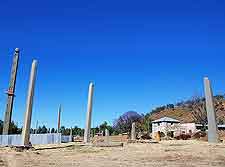
Axum Obelisks
Address: Axum, Ethiopia, ET, Africa
No one really can be sure who created the huge obelisks (stelae) at Axum, or indeed why they were built. Some believe that they were intended as some sort of memorial to the former rulers of Ethiopia, perhaps as long ago as 2,000 to 5,000 years. Whatever the real story behind these beautifully carved monoliths, they still bear more than a hint of mystery for visitors today.
Open hours: daily
Admission: free
Lalibela / Church of St. George (Bete Giyorgis)
Address: Lalibela, Ethiopia, ET, Africa
The town of Lalibela is renowned for its remarkable churches that are hewn out of the rock. There are 11 churches in all, with the most important being the Church of St. George. Indeed, it's thought that this is the largest monolithic church in the world. Most of Lalibela's churches date to the 12th century, although some may go even further back. A labyrinthine guided tour is perhaps the best way to get a sense of the true scale of this site.
Open hours: daily - 08:00 to 17:30
Admission: charge
 A number of impressive geological features and man-made monuments make Ethiopia a fascinating place to visit. These striking landmarks range from waterfalls and caves, to statues and ancient monoliths that are shrouded in mystery even to this day.
A number of impressive geological features and man-made monuments make Ethiopia a fascinating place to visit. These striking landmarks range from waterfalls and caves, to statues and ancient monoliths that are shrouded in mystery even to this day.


